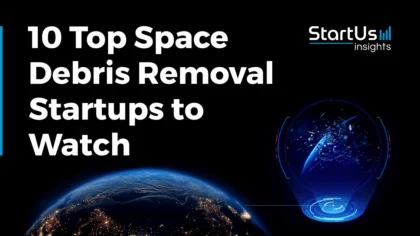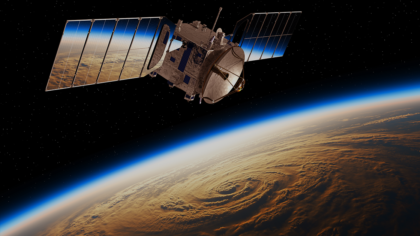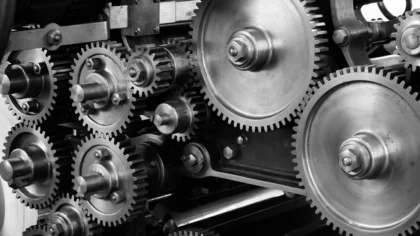Aerospace technology is tackling key challenges like equipment failures, high fuel consumption, and operational inefficiencies. Artificial intelligence (AI) and machine learning, for example, allow for real-time data analysis while improving autonomous systems, predictive maintenance, and supply chain management. Additive manufacturing enables faster production of lightweight and high-performance parts and the integration of the Internet of Things (IoT), big data, and analytics optimizes aerospace operations from design to manufacturing and maintenance. Further, biofuels and electric propulsion are pushing the industry towards greener aviation. These innovations enhance sustainability, efficiency, and safety across aerospace operations.
Why should you read this report?
- Gain in-depth insights into the top 10 technologies impacting retail.
- Learn about three practical use cases for each technology.
- Meet 10 innovative startups advancing these technologies.

Key Takeaways
- Additive Manufacturing
- Use Cases:
- Rapid Prototyping
- Custom Tooling for Aircraft Parts
- Immersive Training
- Startup to Watch: Orbital Matter
- Use Cases:
- Artificial Intelligence (AI)
- Use Cases:
- Predictive Maintenance
- Design Optimization
- Air Traffic Management
- Startup to Watch: Ultraview
- Use Cases:
- Augmented Reality (AR) & Virtual Reality (VR)
- Use Cases:
- Aircraft Maintenance & Inspection
- Immersive Crew Training
- Design and Engineering
- Startup to Watch: Illumia Labs
- Use Cases:
- Big Data & Analytics
- Use Cases:
- Fuel Consumption Optimization
- Predictive Maintenance
- Air Traffic Management
- Startup to Watch: SAT.ASIA
- Use Cases:
- Blockchain
- Use Cases:
- Aircraft Part Tracking
- Secure Data Exchange
- Automated Regulatory Compliance
- Startup to Watch: ADAM Aerospace
- Use Cases:
- CleanTech
- Use Cases:
- Sustainable Aviation Fuel (SAF)
- Electric and Hybrid Aircraft
- Advanced Aerodynamic Designs
- Startup to Watch: SirusJet
- Use Cases:
- Cloud Computing
- Use Cases:
- Real-Time Flight Data Analysis
- Collaborative Aircraft Design
- Scalable Data Storage
- Startup to Watch: Collimator
- Use Cases:
- Connectivity Technologies
- Use Cases:
- Air Traffic Management
- Remote Monitoring
- In-Flight Connectivity
- Startup to Watch: AALYRIA
- Use Cases:
- Internet of Things (IoT)
- Use Cases:
- Environmental Monitoring
- Smart Meters
- Performance Monitoring Sensors
- Startup to Watch: American Sensing
- Use Cases:
- Advanced Robotics
- Use Cases:
- Automated Aircraft Assembly
- Robotic Maintenance Systems
- Space Exploration Robotics
- Startup to Watch: Seaflight
- Use Cases:
Aerospace Industry FAQs
What are the challenges in the aerospace industry?
Rising raw material costs for metals and composites create cost pressures on manufacturers. Also, stringent regulatory environments that focus on safety, emissions, and noise standards, increase the complexity of compliance and development timelines. Further, there is mounting pressure to reduce the carbon footprint of aircraft, which drives the need for sustainable innovation and alternative fuel development. These challenges require continuous adaptation and investment in research to ensure long-term competitiveness.
How do aerospace engineers use technology?
Aerospace innovations use technologies to improve the efficiency, safety, and performance of airplanes and spacecraft. For instance, computational fluid dynamics simulates the flow of air and assists in improving shapes and designs while additive manufacturing accelerates component prototyping and manufacturing. Further, AI-driven simulations and machine learning models predict how systems would behave to pinpoint likely failure points and optimize maintenance cycles. These technologies collectively enhance design precision, reduce production costs, and contribute to meeting the industry’s rigorous safety and performance standards.
Where We Get Our Data From
StartUs Insights gathers data through its exhaustive Discovery Platform, covering information on 4.7 million startups, scaleups, and tech companies globally, alongside 20,000 emerging technologies and trends. The Discovery Platform accelerates startup and technology scouting, trend intelligence, and patent searches, offering thorough insights into technological advancements. By leveraging the trend intelligence feature for this report, we identified emerging technologies within specific industries. This process allows us to uncover patterns and trends, and pinpoint relevant use cases and the startups creating solutions for each scenario. Additional capabilities and information can be found at StartUs Insights Discovery Platform.
10 Technologies Impacting the Future of Aerospace [2025 & Beyond]
1. Additive Manufacturing

Additive manufacturing, or 3D printing, produces lightweight and strong components with intricate designs that would otherwise be extremely expensive and time-consuming to produce in a traditional way. Metal powder-bed fusion and advanced composites are key technologies that produce optimized parts, particularly titanium components, essential for improving fuel efficiency and reducing emissions. The technology improves aircraft design as it allows for more aerodynamically-efficient components that reduce fuel consumption even further. Additionally, 3D printing enables on-demand manufacturing to reduce inventory costs and lead time for aerospace manufacturing.
3 Practical Use Cases of Additive Manufacturing in Aerospace
- Rapid Prototyping: Engineers use 3D printing to produce rapid prototypes of rocket components for testing purposes. This reduces time to market by providing a way to test out different design variations as functional models so that the final products are more optimized at the outset.
- Custom Tooling for Aircraft Parts: Custom tooling for aircraft components is expensive and time-consuming to produce. 3D printing drives down the cost of manufacturing as well as the design time.
- Immersive Training: Engineers gain familiarity with CAD software and simulation tools that are integrated with 3D printing. This helps them gain insights into design performance in real-world conditions before manufacturing.
Startup to Watch: Orbital Matter
Orbital Matter offers 3D printing to manufacture large space structures directly in the microgravity environment of space. This technology uses in-situ resources and maximizes cargo space efficiency by transporting raw materials, which are 3D printed into structures, such as walls for space stations, lunar habitats, and solar power satellites. This approach decouples space structures from the constraints of limited payload volumes, enabling the production of expansive infrastructure that cannot be pre-assembled on Earth. Additionally, its deployable system for satellites enhances efficiency compared to existing solutions. Orbital Matter offers space construction solutions that are scalable and sustainable for the future of space exploration and habitation.
2. Artificial Intelligence

By leveraging technologies like machine learning and deep learning, AI automates decision-making in areas such as cargo handling. Natural language processing (NLP) and AI chatbots analyze passenger preferences, helping airlines streamline customer service operations like baggage handling and providing real-time updates. AI is also applied in autonomous flight planning, utilizing predictive analytics and reinforcement learning to reduce fuel consumption and contribute to sustainability by lowering emissions.
3 Practical Use Cases of Artificial Intelligence in Aerospace Industry
- Predictive Maintenance: AI algorithms analyze real-time data from sensors to identify potential failures and recommend pre-emptive actions. This reduces downtime and improves safety by preventing unexpected breakdowns.
- Design Optimization: AI optimizes aerodynamics, materials, and structural integrity to create more robust aircraft designs. This technology suggests design modifications that reduce material waste and development cycles while improving overall performance.
- Air Traffic Management: AI and machine learning analyze vast amounts of data including weather predictions to optimize flight paths and scheduling. This leads to more sustainable operations and safer airspace management.
Startup to Watch: Ultraview
US-based startup Ultraview offers aircraft inspections by leveraging AI and aerial robotics. The platform features drones with 4K resolution cameras and 3D LiDAR for precise data capture. It also features a companion app for managing flights, analyzing data, and generating reports. The AI component maps aircraft, determines optimal flight paths, and classifies damage types to enhance inspection accuracy and efficiency. Together, these technologies deliver a fully autonomous, scalable solution that improves safety, reduces downtime, and integrates with existing aviation maintenance systems.
3. Augmented Reality & Virtual Reality

The global AR and VR market is projected to grow with an estimated compound annual growth rate (CAGR) of 25.7% by 2032. Specifically in aircraft maintenance and pilot training, AR and VR applications are expanding significantly. AR is utilized in airport designs and expansion by leveraging 3D mapping and cloud-based simulations. Additionally, AR is applied to visualize energy distribution across aircraft systems. Meanwhile, VR offers immersive maintenance training for aerospace workers and improves skills for real-life scenarios. Overall, AR and VR reduce the need for physical prototypes, and physical inspections while enhancing visualization capabilities.
3 Practical Use Cases of AR & VR in Aerospace Industry
- Aircraft Maintenance & Inspection: AR overlays real-time data and digital schematics onto the physical components to deliver step-by-step instructions. This enables technicians to identify potential issues and reduce errors.
- Immersive Crew Training: With VR simulators, trainees experience realistic flight scenarios, including emergency situations, without the risks associated with live training. This leads to better preparedness and a higher level of competency among aviation professionals.
- Design and Engineering: VR visualizes aircraft designs for more effective identification of design flaws and optimization of components. AR overlays design changes onto existing models in real time to facilitate collaboration across geographically dispersed teams.
Startup to Watch: Illumia Labs
Illumia Labs provides AI-powered, virtual human-led solutions for training. The company’s platform features conversational AI avatars like Illumia ENGAGE and Illumia ACTION, which provide interactive, adaptive learning experiences that mimic real-world scenarios with personalized feedback. The no-code scenario and platform builders enable aerospace companies to create immersive digital campuses and labs without coding expertise. Illumia Labs empowers aerospace organizations to enhance onboarding, standardize training, and support continuous skill development.
4. Big Data & Analytics

As the industry shifts towards more data-driven operations, big data and analytics enable process optimization, predictive maintenance, operational cost reduction, and flight safety improvements. With an increasing focus on sustainability and carbon footprint reduction, the technology allows airlines to optimize fuel efficiency and contribute to greener aviation. Big data also enables rapid, data-backed decision-making to support quicker design cycles.
3 Practical Use Cases of Big Data & Analytics in Aerospace
- Fuel Consumption Optimization: Big data and analytics analyze real-time weather patterns, aircraft performance, and traffic conditions to identify efficient flight paths, speeds, and altitudes. This reduces fuel usage, costs, and carbon emissions.
- Predictive Maintenance: Monitors aircraft systems continuously to predict component failures. By analyzing sensor data and maintenance records, it identifies patterns and trends to enable timely interventions.
- Air Traffic Management: BDA streamlines air traffic management by processing vast amounts of flight and environmental data. It predicts traffic congestion, optimizes flight routes, and improves scheduling to reduce delays and increase airspace efficiency.
Startup to Watch: SAT.ASIA
SAT.ASIA develops IoT and big data analytics solutions for the aerospace industry. The company’s ZeroG IoT platform enables efficient wireless data transmission across vast areas, optimizing sensor networks and device connectivity. SAT.ASIA offers services that include structural design, finite element modeling (FEM), stress analysis for both metallic and composite materials, and fatigue and damage tolerance analysis. These solutions enhance operational efficiency and support the development of aerospace technologies.
5. Blockchain

Blockchain enables a decentralized, immutable record of transactions to improve traceability of the entire lifecycle of aircraft parts, from manufacturing to end-of-life. Digital ledgers, cryptographic hashing, smart contracts, and decentralized peer-to-peer (P2P) networks enable real-time access to accurate data and reduce reliance on paper-based records. This streamlines supply chain management. Further, combining blockchain with predictive analytics, big data, and other technologies improves maintenance processes and reduces downtime.
3 Practical Use Cases of Blockchain in the Aerospace Industry
- Aircraft Part Tracking: Blockchain records every transaction regarding aircraft parts and their movement in a secure, immutable ledger. This transparency prevents counterfeit parts and ensures authenticity throughout the aircraft’s lifecycle.
- Secure Data Exchange: It secures data exchanges between manufacturers, suppliers, and regulators by encrypting transactions and providing a tamper-proof record. This reduces risks of data breaches and ensures compliance with industry standards.
- Automated Regulatory Compliance: Blockchain automates compliance processes by embedding regulations into smart contracts. These reduce manual checks and speed up certification processes, thereby increasing efficiency and reducing costs.
Startup to Watch: ADAM Aerospace
ADAM Aerospace delivers cryptography and cybersecurity solutions. The company’s technology, Zenith 0, employs a private distributed ledger with cryptographic techniques to secure and authenticate critical data across multiple checkpoints. Additionally, Trident AI, the company’s AI-driven platform, enhances threat detection, real-time data analysis, and decision-making by leveraging machine learning algorithms trained on vast defense datasets. Together, these technologies protect vital information in aerospace operations.
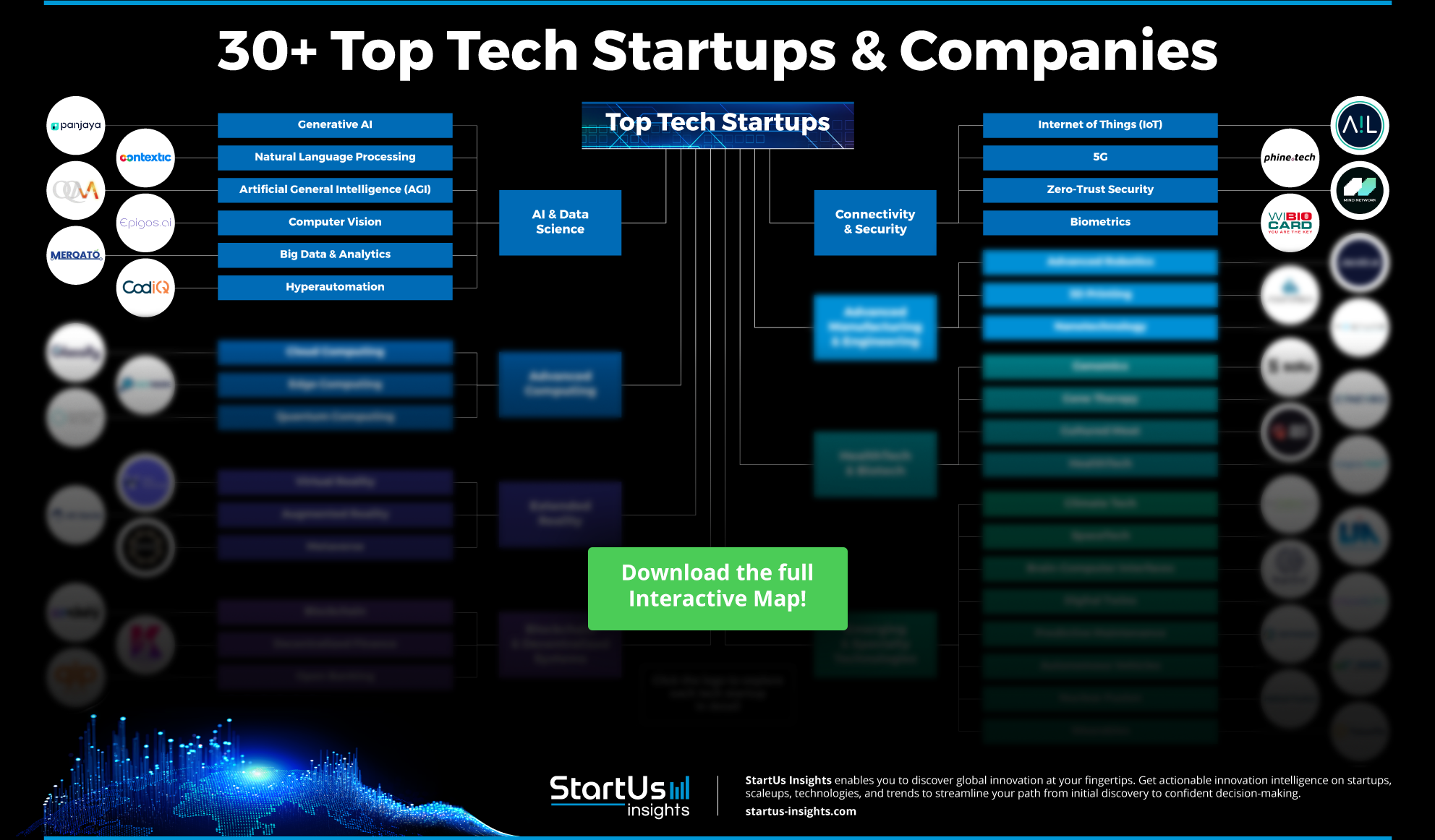
6. CleanTech

The aerospace industry is integrating renewable energy as the demand for sustainability and energy-efficient operations increases. This includes hydrogen-powered ground support equipment (GSE) and cargo loaders at airports to reduce airport emissions. Closed-loop recycling for composites and metals further decreases the dependence on virgin raw materials. Additionally, bio-based lightweight polymers in manufacturing cabin interiors or systems as well as biofuels reduce fuel consumption.
3 Practical Use Cases of Cleantech in the Aerospace Industry
- Sustainable Aviation Fuel: Replaces fossil-based fuel with bio-based alternatives to lower the industry’s carbon footprint.
- Electric and Hybrid Aircraft: Use electric propulsion systems for cleaner, quieter flights. This contributes to the industry’s goal of achieving zero-emission aviation.
- Advanced Aerodynamic Designs: Improve fuel efficiency by reducing drag on aircraft. This optimizes aircraft shapes and surfaces, leading to a more sustainable aviation industry.
Startup to look for: SirusJet
SiriusJet develops a hydrogen-powered regional aircraft with vertical takeoff and landing (VTOL) capabilities. It utilizes a hydrogen-electric ducted fan propulsion system with high-density hydrogen storage and an advanced fuel cell system for efficient energy conversion and extended flight range. Engineered for high altitudes, the aircraft achieves cruise speed while maintaining low noise levels. It is also equipped with an airframe parachute system for enhanced safety, and its lightweight composite materials contribute to cost-effective and zero-emission operations.
7. Cloud Computing

Cloud computing improves data management, collaboration, and operational efficiency in the aerospace industry. It integrates hybrid cloud solutions, infrastructure as a service (IaaS), and advanced analytics to support critical aerospace functions. Hybrid cloud systems allow aerospace companies to leverage public and private cloud infrastructure while reducing IT overhead. Additionally, cloud computing enhances cybersecurity with zero-trust security models, improved data resilience, and secure collaboration.
3 Practical Use Cases of Cloud Computing in the Aerospace Industry
- Real-Time Flight Data Analysis: Allows airlines to analyze aircraft performance, plan the optimal flight route, and immediately resolve current issues to prevent delays and improve safety.
- Collaborative Aircraft Design: Cloud computing provides a shared platform to facilitate the coordination of aircraft design. Engineers and designers can exchange their thoughts while being in various locations.
- Scalable Data Storage: Cloud computing offers scalable data storage for aerospace companies, ensuring that vast amounts of data from aircraft operations, maintenance, and manufacturing are securely stored and easily accessible. This supports data-driven decision-making and improves overall operational efficiency.
Startup to look for: Collimator
Collimator delivers a cloud-based simulation and modeling platform. It enables engineers to design, simulate, and optimize complex dynamical systems through surrogate modeling, digital twin support, and model-predictive control. Its high-performance computing (HPC) capabilities allow large-scale simulations, such as Monte Carlo simulations and hardware-in-the-loop (HIL) testing, to be run in parallel on the cloud. The platform supports extensive data visualization through interactive tools, including time graphs, Bode plots, and FFT plots, and integrates seamlessly with existing engineering tools to streamline workflows. These features enable aerospace companies to ensure highly efficient and scalable system development.
8. Connectivity Technologies

Connectivity technologies are enabling faster access to critical information, seamless communication, and enhanced data exchange. These technologies include 5G, 6G, and satellite communication. They ensure real-time data transfer and interoperability in various aerospace components. For example, 5G offers high-speed, low-latency communication for efficient in-flight connectivity and improved communication between pilots, ground control, and other aircraft. It also supports advanced use cases such as autonomous operations, predictive maintenance, and enhanced passenger experiences. The integration of 5G with private networks and edge computing further strengthens connectivity, while satellite communication ensures uninterrupted connectivity across different altitudes and regions.
3 Practical Use Cases of Connectivity Technology in the Aerospace Industry
- Air Traffic Management: Connectivity technologies provide real-time data on aircraft positions and movements to improve air traffic management. This optimizes flight paths, reduces delays, and manages airspaces more effectively.
- Remote Monitoring and Control: Ground crews assess performance and troubleshoot issues instantly to enhance safety and operational efficiency by addressing problems before they escalate.
- In-Flight Connectivity: Advanced satellite communications and 5G provide high-speed internet access during flights. This improves the travel experience thus enabling passengers to stream content, browse the internet, and stay connected in the air.
Startup to look for: AALYRIA
US-based AALYRIA develops optical communication solutions for the aerospace industry. Its two technologies are Tightbeam, a coherent light free-space optics technology, and Spacetime, a network orchestration platform. Tightbeam offers high-speed, long-distance data transfer through atmospheric laser communication to enhance connectivity for satellite communications, aircraft, and ships. Meanwhile, Spacetime orchestrates complex networks across land, sea, air, and space to optimize antenna scheduling, traffic routing, and spectrum management. Aalyria enables high-speed communication for aerospace applications.
9. Internet of Things

IoT shifts the aerospace sector towards increased automation and data-driven decision-making. For example, airline companies use smart cabins to improve passenger experience through real-time monitoring of passenger needs. Similarly, IoT tracks both in-flight inventory and passenger baggage to reduce the probability of lost luggage. IoT-enabled digital twins create virtual replicas to simulate and test aircraft performance. This reduces the need for physical prototypes for precision testing and design.
3 Practical Use Cases of the Internet of Things in the Aerospace Industry
- Environmental Monitoring: IoT devices monitor air quality and noise levels at airports. This allows businesses to comply with environmental regulations and implement measures to minimize their ecological impact.
- Smart Meters: Provide insights into real-time data on energy usage by analyzing consumption and recommending energy-saving measures to improve sustainability throughout the production process.
- Performance Monitoring Sensors: Monitor aircraft performance and offer real-time data to reduce downtime. By addressing issues immediately, these sensors enable aerospace companies to reduce aircraft downtime and maintenance costs.
Startup to look for: American Sensing
US-based startup American Sensing provides custom and commercial off-the-shelf (COTS) sensors. The company develops pressure, level, submersible, acceleration, temperature, and vibration sensors, as well as load cells for aerospace IoT applications. Its sensors operate in harsh environments, from deep ocean pressures to extreme space conditions, with ranges up to 100,000 psi and temperatures from -320°F to 400°F. The company also offers various sensing technologies, like MEMS and capacitive sensors, to ensure precise monitoring. This enables reliable data acquisition to enhance performance, safety, and operational efficiency in aerospace operations.
10. Advanced Robotics

Robotics enable aerospace companies to transition towards more automated, flexible, and scalable operations. This shift is primarily focused on increasing production efficiency and improving safety. For example, robotics automate the transportation of large aircraft components within assembly facilities, including heavy lifting. Similarly, unmanned aerial vehicles (UAVs) inspect aircraft and survey large construction sites to detect defects. These innovations optimize manufacturing processes, reduce costs, and improve overall safety in aerospace operations.
3 Practical Use Cases of Robotics in the Aerospace Industry
- Automated Aircraft Assembly: Robots ensure consistency in tasks such as drilling, riveting, and welding which are prone to human error. This results in faster production times and higher-quality assemblies.
- Robotic Maintenance Systems: Perform routine tasks, such as aircraft maintenance, through automated inspections and repairs. Robots identify issues that human eyes might miss to increase maintenance efficiency.
- Space Exploration Robotics: Execute tasks that are too dangerous or impossible for humans. For example, robotic arms and rovers are deployed to collect data and repair satellites.
Startup to look for: Seaflight
Seaflight builds electric drones for same-day cargo delivery. The drones utilize a proprietary aerodynamic flow control system to energize airflow over wings for ultra-high lift during takeoff and landing. This ensures operations from short and rough fields. This technology supports slim, high-aspect-ratio wings that significantly reduce drag and enhance cruise efficiency. Seaflight’s drones offer a sustainable, cost-effective solution for the air cargo industry without compromising on payload capacity or operational flexibility.
Outlook for the Aerospace Industry
Patents & Grants
The aerospace science and technology industry experiences robust growth driven by a strong focus on innovation, reflected in the issuance of over 56,900 patents and 2,550 grants. This volume of intellectual property demonstrates an active commitment to advancing technological frontiers across various subfields, including propulsion systems, avionics, and space exploration technologies.
For more actionable insights, download our free Aerospace Innovation Report.
Investment Landscape
Leading investors, including Creative Destruction Lab, Techstars, Y Combinator, AWS Space Accelerator, and the Cassini Initiative, continue to drive capital inflows into aerospace startups. Funding primarily occurs through seed, accelerator/incubator, early-stage VC/Series A, pre-seed, and angel rounds, with average funding per round reaching USD 11.9 million.
Global Footprint
The aerospace sector employs over 9 million people worldwide, with major country hubs located in the USA, UK, India, Germany, and Canada. Leading city hubs, such as London, New York City, Bangalore, Dubai, and Houston, further solidify the industry’s global influence and extensive workforce distribution.
Act Now to Take Advantage of Top Aerospace Technologies
Take immediate action on the top emerging aerospace technologies to stay ahead in the industry. StartUs Insights empowers you to uncover hidden opportunities among 4.7 million startups and tech companies, alongside insights into 20,000 technologies and trends. Our AI-powered, real-time database provides unparalleled access to solutions that are not available elsewhere, ensuring you always lead in innovation. Major companies like Samsung, Nestlé, and Magna rely on our tools to spearhead trends and optimize operations. Dive into unmatched data and benefit from a 360-degree industry view for actionable insights. Get in touch with us now to discover how our innovation intelligence can elevate your strategic initiatives.
Discover All Emerging Aerospace Technologies & Startups!

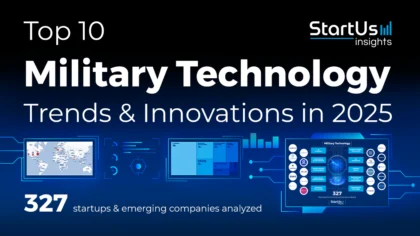
![15 Top Defense Companies and Startups to Watch in Europe [2025]](https://www.startus-insights.com/wp-content/uploads/2025/03/Defense-Companies-in-Europe-SharedImg-StartUs-Insights-noresize-420x236.webp)
